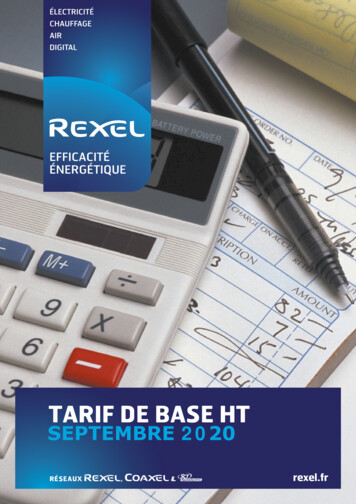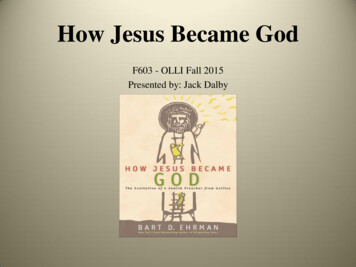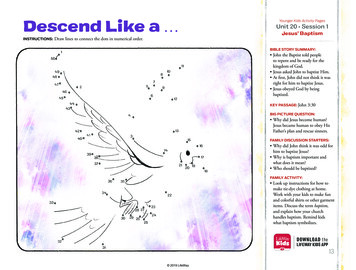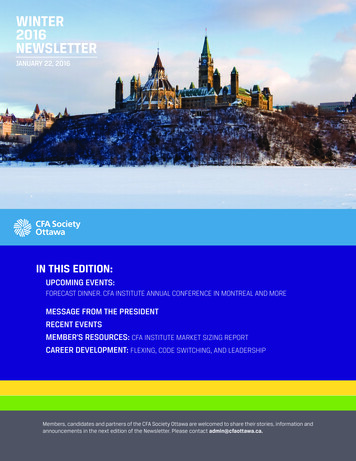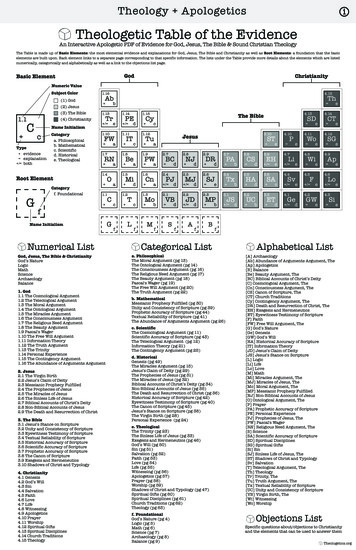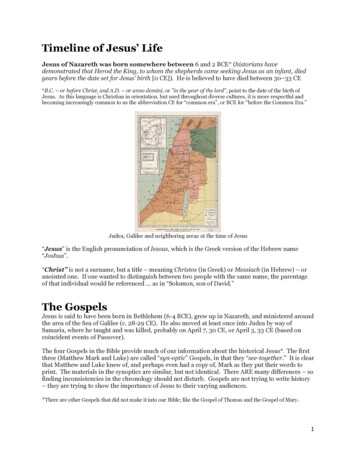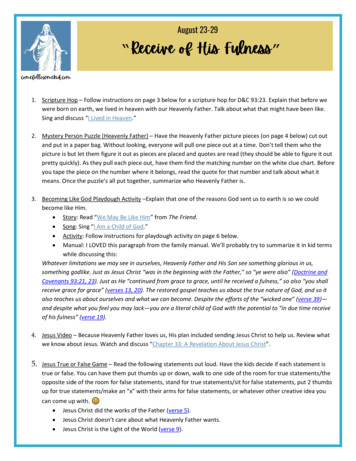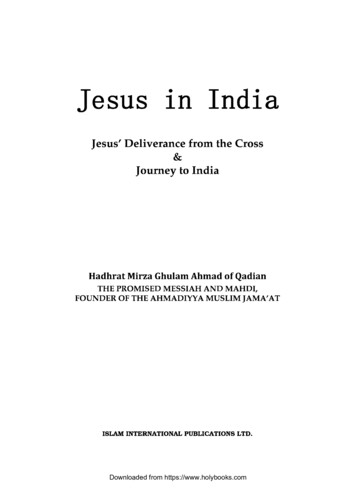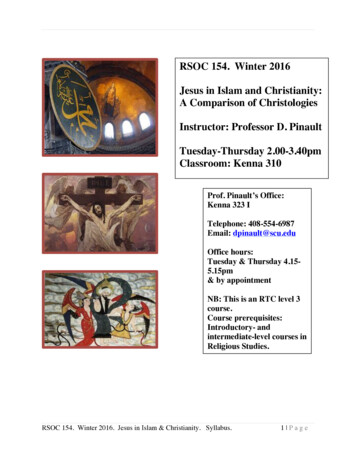
Transcription
RSOC 154. Winter 2016Jesus in Islam and Christianity:A Comparison of ChristologiesInstructor: Professor D. PinaultTuesday-Thursday 2.00-3.40pmClassroom: Kenna 310Prof. Pinault’s Office:Kenna 323 ITelephone: 408-554-6987Email: dpinault@scu.eduOffice hours:Tuesday & Thursday 4.155.15pm& by appointmentNB: This is an RTC level 3course.Course prerequisites:Introductory- andintermediate-level courses inReligious Studies.RSOC 154. Winter 2016. Jesus in Islam & Christianity. Syllabus.1 Page
Course description.A prefatory comment: Too often, in my experience, Muslim-Christian dialogue, motivated by apraiseworthy and entirely understandable desire to minimize violence and destructive prejudice,tends to emphasize whatever the two religions share in common. Interfaith gatherings motivatedby such concerns sometimes neglect points of substantive difference between the faiths,especially with regard to Islamic and Christian understandings of Jesus.This is regrettable, and certainly not the approach I propose to attempt as you and I undertakethis course. Instead, while acknowledging certain similarities between Islam and Christianity,and giving attention to the highly important commonalities they share with Judaism (all threefaiths, it should be noted, are given a special shared status in Islamic theology as al-adyan alsamawiyah, “the heavenly religions”), I nonetheless will emphasize the radical differencesbetween Islam and Christianity in their understandings of Jesus.I do this for a specific reason. I believe that highlighting only the similarities between thesetraditions does a disservice to both, whereas a critical yet sympathetic comparison of Islamic andChristian Christologies allows us to appreciate the distinctive spiritual treasures available in eachreligion. Both religions, after all, make sincere attempts to ask: what does it mean to experienceGeworfenheit (as the German philosopher Martin Heidegger would say), the state of “havingbeen flung into existence,” of having to negotiate the reality of being a flesh-and-blood human,with all the consequent limitations of finitude, awareness of death, and idealistic aspirations—even if barely understood or articulated—aspirations that lead humans through their flesh-andblood nature to yearn for an experience of the Transcendent.The Christologies of each of these religions are ways of addressing this existential reality ofGeworfenheit from varying Abrahamic perspectives, which is to say: the more we study theChristologies of Islam and Christianity, the more we come to realize that Muslim and Christianunderstandings of Jesus are ways of talking about how humans experience the Transcendent.Moreover, I believe that studying the Jesus of Islam and Christianity in tandem, giving specialattention to their divergent approaches, causes each faith to shed new light on the other, therebyoffering fresh perspectives on important questions that (consciously or unconsciously) concernus all: What does it mean to be a faithful Muslim or a faithful Christian or—more generally,regardless of how we identify ourselves—a person who cultivates spiritual interiority?To achieve these goals, this course investigates understandings of Jesus in a variety of textualsources: the Qur’an; Islamic folklore and poetic/mystical traditions; polemical workscondemning Christian Christology; apocryphal and Gnostic Christian texts of the Near East; andGospel accounts contained within the Christian Bible. We will read the Qur’an and the Bibleside-by-side; this juxtaposed reading has the goal of generating fresh understandings of Christianand Islamic Christologies. Such an investigation is conditioned by my own identity as a CatholicChristian whose professional area of work involves the study of Islam.Course content: RSOC 154 offers an introduction to Islamic theology and Qur’anic Christology,with attention to Muslim scriptural understandings of Jesus as a prophet and healer. Thereafterwe examine representations of Jesus in Sufi mysticism, medieval Islamic folklore, and modernRSOC 154. Winter 2016. Jesus in Islam & Christianity. Syllabus.2 Page
Arabic literature. The course includes consideration of the extent to which understandings ofJesus can play a role in Muslim-Christian dialogue.This course is intended to provide the background necessary to appreciate the history and currentstatus of Muslim-Christian relations. To do this we will explore representations of the figure ofJesus in Qur’anic scripture, vernacular Islamic literature of the Middle Ages, and contemporaryArabic poetry. Additionally, in this course we will examine the concept of prophethood in theAbrahamic traditions by comparing representations of Jesus and Muhammad in Christianity andIslam. Because I cannot assume a prior knowledge of Islam on the part of students beginningthis course, I will include an overview of Islamic doctrine and Qur’anic teachings in the initialweeks of the quarter.The course begins with an introduction to the cosmology of the Jahiliyah (the religion andsociety of the pre-Islamic Arabian peninsula) and then compares this with the worldviewpresented in the Qur’an. Discussion of the Qur’anic understanding of prophethood will befollowed by a close reading of textual passages concerning Jesus in both the Qur’an andmedieval Islamic devotional literature. We will work with this textual material to construct anIslamic Christology. Here I emphasize how Qur’anic Christology illustrates larger Islamicbeliefs concerning humankind’s relation to the Divine and the ways in which humans areexpected to function with regard to the world they inhabit.The course then moves on to examine portraits of Jesus in medieval Sufi mystical literature andthe Sufis’ use of the Islamic Jesus to criticize the religious hierarchy of Muslim society.Thereafter we will study how present-day Muslim Arab poets—especially members of the“Tammuzi” movement—combine the figure of Jesus with references to pre-Islamic pagan godsto create a mythological landscape of suffering and hoped-for redemption as a way of describingcontemporary Arab societies. Course readings will include the testimony of both Christianconverts to Islam and Muslim converts to Christianity.It is the argument of this course that frankly acknowledging and exploring such differences inChristological understanding constitute a prerequisite to interfaith dialogue that is in any waysubstantive and meaningful. Analysis of the variant Christologies present in Islam andChristianity will position students to ask the question: does the shared heritage of these twofaiths as Abrahamic traditions offer any significant basis for collaboration on contemporaryglobal concerns?RSOC 154 and Santa Clara University’s Core Curriculum.RSOC 154 has been approved as an RTC (Religion, Theology & Culture) level 3 course. SantaClara University’s Core Curriculum guidelines list as follows the goals of RTC 3 courses:“Critical thinking; ethical reasoning; religious reflection; perspective.”The Core Curriculum guidelines list as follows the Core Learning Objectives for RTC 3 courses:--“Students will be able to identify diverse perspectives and evaluate ethical positions oncontemporary questions.”--“Students will be able to evaluate and apply insights from the study of religion to open-endedquestions facing contemporary society.”RSOC 154. Winter 2016. Jesus in Islam & Christianity. Syllabus.3 Page
Assessment of learning.The final grade will be assigned on the following basis:There will be four essays, each worth 15% of the final grade.The first essay will involve your comparison of Qur’anic and Biblical concepts of prophethood.Here you will take into account the Islamic doctrine of ‘ismah (infallibility/sinlessness/divineprotection from error). Reflection on this doctrine will illuminate Islamic understandings of bothJesus and Muhammad.In your second essay, you will investigate a spiritual odyssey that moves from Islam toChristianity. Our primary-source text for this assignment will be Seeking Allah, Finding Jesus,by an ex-Muslim named Nabeel Qureshi. You will be asked to do two things in this essay. First,you will compare the conversion experiences of ex-Christians (as anthologized in Haleem’s text)and of an ex-Muslim (as recounted by Qureshi), evaluating the ethical implications of the socialresponses they encounter (ranging from acceptance to harassment and ostracism) with regard toissues of freedom of conscience and religious pluralism. Second, you will apply insights fromour classroom analysis of Islamic and Christian scripture to evaluate Qureshi’s comparativeChristology and to consider the question: can Muslim and Christian understandings of Jesus beharnessed so as to facilitate interfaith understanding rather than trigger competitiveproselytizing?The third essay will take the quest for interfaith understanding down the path of Sufism (themystical tradition within Islam). Here you will analyze the primary-source portraits of Jesus inmedieval Islamic legend and literature that are gathered in Tarif Khalidi’s anthology The MuslimJesus, and you will evaluate these medieval Sufi perspectives on Jesus in light of several sourcesthat influenced Sufi Christology: the Qur’an, Muslim folk narratives derived from episodesrecorded in the New Testament, and the “Arabic Infancy Gospel.” The Jesus portrayed inKhalidi’s anthology is very much an exemplar of the Sufi lifestyle; in the final part of thisassignment, you will evaluate the moral dimensions of this “Sufi Christ” in light of the barrageof condemnations directed against Sufi faith and practice by contemporary Wahhabi Islamistssuch as Ismail al-Faruqi.The fourth essay will give you the chance to evaluate 21st-century writings by contemporaryMuslims who cite the suffering, anguish, and doubt experienced by Jesus as portrayed in theNew Testament in an attempt to disprove his divinity. You will compare these writings with theliterary work of the so-called “Tammuzi” school of poets—Arab authors, many of them Muslim,who identify themselves intensely in their own personal sorrows and political struggles with thesufferings and even the Crucifixion of Jesus that are critiqued by fellow-Muslim polemicists.Finally, this essay will also lead you to explore how the kenotic Christology of Catholic writerssuch as theologian Hans Urs von Balthasar embraces precisely the notion of divine suffering thathas been condemned by so many Muslim polemicists.These four essays will afford you opportunities to identify diverse perspectives and evaluateethical positions on contemporary questions in today’s Islamic societies. Furthermore, you willbe able to evaluate and apply insights from the study of Islam and Islamic Christology toRSOC 154. Winter 2016. Jesus in Islam & Christianity. Syllabus.4 Page
questions facing both Muslims and non-Muslims in contemporary society, especially withregard to issues relating to evangelization, apostasy, and freedom of conscience.The research project is worth 20% of the final grade. This may involve a focus on either textualanalysis or ethnographic research. With regard to the latter focus, please note the following:Several Bay Area places of worship are particularly relevant to the themes explored in thiscourse. Two—the South Bay Islamic Association, in San Jose, and the Naqshbandi Sufi Tariqah,in Oakland—include significant numbers of ex-Christian converts to Islam. The third—theIranian Christian Church, in Sunnyvale—is composed largely of ex-Muslim converts toChristianity. You have the option of soliciting interviews with members of these congregationsto discuss topics such as the following: a.) how their understandings of Jesus have changed anddeveloped in the course of their own personal spiritual journeys; and b.) how their conversionshave affected their self-understanding in relation to their families, local communities, and theglobal population of believers (and non-believers). Attending worship services at these sites andinterviewing members of these congregations will give you the opportunity to create a researchproject in which you integrate ethnographic field data with textual analysis of primary sourcesrelated to representations of Jesus in the Islamic and Christian traditions.This research paper will offer you opportunities to identify and evaluate diverse perspectives onconversion and religious identity. Furthermore, you will be able to evaluate and applyinsights from the study of Islamic Christology to open-ended questions—notably the searchfor spiritual meaning in pluralistic settings, and the dialectic between personal identity andcommunal identity—facing contemporary societies, both in the San Francisco Bay Area andabroad in Muslim communities worldwide.Class participation is valued at 20% of the final grade.This is meant to encourage your daily engagement with the assigned materials, so that youdevelop the discipline of identifying perspectives on contemporary questions in Islam andevaluating these issues on an ongoing basis throughout the academic quarter. Dailyparticipation, like the writing assignments described above, is structured so as to facilitatereligious reflection: analysis of how contemporary Muslims and Christians understandChristology (whether Qur’anic or Biblical) in relation to issues of conversion, proselytizing, andinterfaith relations will encourage you to reflect on how you integrate your own personal andspiritual identity in today’s globalized and pluralistic world.Performance feedback. In addition to written remarks which I will append to each essay,research prospectus, and research project that I evaluate and return to you, I encourage you tomeet with me individually in my office so that we can discuss your performance, both withregard to your written work and your classroom participation. I particularly urge you to meetwith me before each written assignment is due, so that I can discuss with you outlines and roughdrafts as you work on each paper. This will help you build confidence as you learn to identify,articulate, and communicate your thoughts in writing.Islamic Studies Pathway. This course is associated with SCU’s Core Curriculum Pathway inIslamic Studies. If you declare a Pathway in this area, you may use a representative piece ofwork from this course in the Pathway portfolio you will complete during your senior year.RSOC 154. Winter 2016. Jesus in Islam & Christianity. Syllabus.5 Page
COURSE SYLLABUS.(Please note: readings are to be completed in time for the class under which they are listed. Besure to bring to class the books and photocopied materials assigned for the given day.)1.) Tuesday, January 5.Introduction to the course: what the study of Jesus can bring to the understanding of Islam andChristianity. Methodology and terms. The religion of the Jahiliyah: culture, tradition, andvalues in the Arabian peninsula of the pre-Islamic era. Discussion of Writing Exercise.Topics to be discussed in your Writing Exercise: A.) a statement in which you identify andbriefly reflect on your own personal worldview, however you define this for yourself (whether interms of denominational religious affiliation, unaffiliated spirituality, self-identification as anagnostic, skeptic, atheist, freethinker, etc.). B.) a discussion of whatever previous experience—whether devotional, doctrinal, academic, or pop-cultural—you’ve had of the figure of Jesus, withconsideration of whether Jesus plays any role in your worldview and personal life as describedabove in part A. C.) A discussion and brief analysis of the following primary-source readings:Qur’an: 3.42-59; 4.155-159; 5.109-118; 9.30-31; 19.16-38 (Note especially n.2485 in A.Y. Ali’stranslation!); 19.88-90; New Testament: Gospel of Mark: chapters 1-4; 5.24-34; chapters 14-16;Gospel of Luke: 1.26.-38; Gospel of John: 1.1-18; First Letter to the Corinthians: 11.23-26 (areference predating the Gospels to the Last Supper); First Letter to the Thessalonians: 5.9-11 (areference to the purpose of Jesus’s death from one of the very earliest New Testament texts).Compare the Islamic verses relating to Jesus in the Qur’an with the above Christian verses fromthe New Testament, noting both similarities and differences with regard to doctrinal teachings,emotional tone and literary style. What is your own personal response to this literature? Usebrief citations from the above sources in support of your argument.Minimum length of assignment: 750 words/3 pages, typed, double-spaced. Suggestedmaximum length: 1,250 words/5 pages.NB: This is an ungraded assignment. But failure to submit this assignment at the beginning ofclass this Thursday, January 7, will result in the lowering of your final grade for this courseby at least one step (eg, from C to C-). Your final course grade will be lowered an additionalstep for each day late this assignment is submitted (eg, if your assignment is submitted on Friday,January 9, your final grade will be lowered two steps—eg, from C to D ). NB: Latenesspenalties also accrue over the weekend; this pertains to ALL of the writing assignments forthis quarter! I will offer written comments on what you submit, and you will incorporate arevised version of portions of your writing exercise in the various essays you submit later in thequarter.2.) Thursday, January 7.WRITING EXERCISE DUE.The early life of the prophet Muhammad. The Qur’an: tawhid (divine oneness) and finaljudgment. Human nature as depicted in Islamic scripture. Qur’anic responses to the Jahiliyah.The Prophet Muhammad in Mecca: initial revelations of the Qur’an and Islamic views of theafterlife.Readings: Faruqi, 1-44 (chapters 1- 3); Qur’an, surahs (chapters) 1, 96, 112 (tawhid and humannature); 45.21-35 (cf. 44.34-42) (judgment, the natural world, and the Jahiliyah); 4.131, 6.133RSOC 154. Winter 2016. Jesus in Islam & Christianity. Syllabus.6 Page
(cf. n.955), 10.68, 29.6 (cf. n.3428), 31.12 (cf. n.3594), 31.26 (cf. n.3615), 35.15 (cf. n.3898),39.7 (cf. n.4254), 60.6 (cf. n.5419), 64.6 (cf. n.5486) (Allah’s “attribute/name” as al-Ghani {cf.A.Y. Ali’s index, p.1726, s.v. “Allah’s attributes ‘free of all wants’ [Al-Ghani]”}). Readentire syllabus. Begin readings for first essay assignment.Questions for classroom discussion:What do surahs 1, 96, and 112 tell us about God, human nature, and divine-human relations?What does the Qur’an say about: human nature; the physical world; the afterlife; the values ofthe Jahiliyah? What do the Qur’an passages relating to God’s attribute as al-Ghani suggest aboutIslamic understandings of divine-human relations?3.) Tuesday, January 12.The natural world in relation to divinity. The Qur’an: silsilat al-anbiya’ (“the chain of theprophets”). The patterns of human history according to Qur’anic revelation.Readings: Qur’an, chapter 7 (the chain of the prophets) and chapter 55; Faruqi, 45-80.Questions for classroom discussion:How does surah 55.1-34 portray the natural world in relation to Allah? Discuss Faruqi’spresentation of how “nature and wealth” are viewed in Islam (see esp. Faruqi, pp.7-8 and chapter5 in his book). Qur’an, chapter 7: Describe the recurrent patterns of human history and theevents that tend to befall prophets as described in this chapter. How does Qur’an 7.182-185clarify the themes of this chapter? Compare the story of Noah in this Qur’anic chapter with thestory of Noah as presented in the Bible (Genesis, chapters 6-9).4.) Thursday, January 14.FIRST ESSAY ASSIGNMENT DUE.The prophet Muhammad in Medina. The“greater” and the “lesser” jihad. The exemplary statusof Muhammad: the role of sunnah and hadith. Implications of the doctrine of prophetic ection from error; cf. adj. ma‘sum) for Islamic ethics. Acomparison of prophetic portraits in two scriptures: David in the Bible and Qur’an.Readings: Abu A‘la Mawdudi, “The Prophethood,” 29-35 (photocopy, from Mawdudi’s bookTowards Understanding Islam); Pinault, “The Doctrine of Prophetic ‘Ismah in Islam: Readings”(photocopy); “The Sunnah of the Prophet: A Sampling of Exemplary Behavior and Statements”(Pinault, 2 pp., photocopy handout) & “The Prophet Muhammad and His Interactions withCertain Poets, Singers, and Storytellers” (Pinault, 3 pp., photocopy handout). Qur’an 80.1-10(Muhammad and the blind man). Bible, First Samuel, chapter 16.14-23, chapter 17(King Saul,David, and Goliath); Second Samuel, chapters 11 and 12 (David, Bathsheba, Uriah, and Nathan).David in the Qur’an: surahs 2.249-251 (Talut King Saul), 27.15, 38.12-26 (cf. note 4178 inAli’s Qur’an commentary).FIRST ESSAY ASSIGNMENT:a.) Summarize and evaluate Mawdudi’s concept of prophethood, especially with regard to whatit implies about human nature and ethics. b.) What portrait of the prophet Muhammad emergesfrom the sunnah/hadith and biographical data in “The Sunnah of the Prophet” and “The ProphetMuhammad and His Interactions ”? What are the moral implications and challenges associatedwith this material, in light of the doctrine of prophetic ‘ismah as presented by Mawdudi and ourother Islamic sources? c.) Compare the portraits of David in the Bible and Qur’an. Compare inparticular the Biblical and Qur’anic versions of the story of the “dispute over the ewes.” WhatRSOC 154. Winter 2016. Jesus in Islam & Christianity. Syllabus.7 Page
does Abdullah Yusuf Ali say about this? What is his view of prophetic ‘ismah? (see hiscommentary, esp. note 4178). d.) Based on your reading of the above material, compare Biblicaland Islamic concepts of divinely appointed sacred leadership/prophethood, taking into accountwhat these texts imply concerning human nature, morality, and human relations with the divine.What is your own evaluation of, and personal response to, this material? NB: These questionswill also be addressed in today’s classroom discussion.5.) Tuesday, January 19.The Qur’an: Islam as an Abrahamic faith. Qur’anic interpretations of Judaism and Christianity.Community, family, and issues of personal identity in the Qur’an. The dhimmi and jizyah andthe question of tolerance: Qur’anic verses on the status of Jews, Christians, and other nonMuslims.Readings: Bible, Deuteronomy 6.1-9 (Catholic Study Bible, pp.207-208; Dt. 6.4-9 is known inJudaism as the “Shema” [from Hebrew shema “hear”]); “The Martyrdom of Rabbi Akiba” fromThe Babylonian Talmud (1-page photocopy: Rabbi Akiba [also known as Akiva ben Joseph] isrevered as one of the founders of rabbinic Judaism and was reputed to be a supporter of the BarKokhba revolt. Akiba was executed (c.AD 132-137) by the Roman state for publicly practicingand teaching the Jewish faith); Qur’an: chs. 6.71-92 & 21.51-75 (Abr. and Azar); 37.99-111(Abr.’s sacrifice of his son); 2.125-129 (Abr., Isma’il, and the Kaaba); 3.64-68 (Abr. as a hanif);Qur’an 5.51, 3.85, 9.28-31 (cf. the term jizyah in 9.29), 11.118-119, 5.48, 5.69-77 (cf. esp.mithaq Bani Isra’il, “the Covenant of the Children of Israel,” 5.70), 5.82-86 (note how theQur’an ranks Christians in relation to Jews), 2.62, 2.256,18.29-31, 10.98-103 (the status of nonMuslims); review Faruqi, 59-80 (chapter 6, “The Islamic World Order” and chapter 7, “IslamicCulture and History”).Questions for classroom discussion:What do the biblical Shema and the account of “The Martyrdom of Rabbi Akiba” suugest to youabout affinities between Jewish and Islamic doctrines? What do the above Qur’anic passages sayabout Abraham? What does the Qur’an say with regard to salvation for non-Muslims? Evaluatethe status of non-Muslims in contemporary Islamic societies in the light of Faruqi’s discussion of“the Islamic world order,” ummah, da‘wah, and jizyah.6.) Thursday, January 21.A first look at the question of conversion: the issue of Christians “reverting to” or “embracing”Islam. “Natural religion,” primordial intimacy with Allah, and conversion to Islam: theimplication of the Qur’anic verse “Am I not your Lord?”Readings: Qur’an 7.172; Haleem, The Sun Is Rising in the West, preface (xv-xviii), 27-29, 3637, 58-61, 64-66, 67-71, 74-75, 76-83, 109-112, 118-120, 121-127, 128-140.Questions for classroom discussion: What motivates the individuals described in theseautobiographies (Haleem, pages indicated above) to convert to Islam? What strikes you asinteresting in the spiritual journeys undergone by these “new Muslims”? What attracts them toIslam? Do you see any patterns or common factors in their background or experiences? Analyzewhat these converts say about Christianity, Christian teachings, Jesus, and their previousreligious background or lack thereof. What is your own assessment of the assertions andexperiences presented in this book?RSOC 154. Winter 2016. Jesus in Islam & Christianity. Syllabus.8 Page
7.) Tuesday, January 26.Qur’anic Christology (I). Depictions of Jesus in the Qur’an. “Shubbiha la-hum” and thequestion of al-tashbih: the legacy of Gnosticism and Gnostic forms of Christianity in theQur’an’s docetic Crucifixion. Qur’anic references to the Prophet Muhammad. A comparison ofthe Qur’an’s representation of Muhammad and Jesus.Readings: Hans Jonas, The Gnostic Religion, 42-47 (Camino); The Nag Hammadi Library: “TheSecond Treatise of the Great Seth,” 362-371, and “Apocalypse of Peter,” 372-378 (Camino).Qur’an 112.1-4 (the question of divine sonship); 3.42-59 (the Virgin Mary and the miracles ofJesus); 4.155-159 (the docetic crucifixion); 5.116-120 (Jesus and the Last Day); 97.1-5 (“TheNight of Power”); 53.1-18 (the Prophet’s mystical experience of the Divine); review 80.1-12 (theProphet and the blind man); 33.40 (Khatim al-nabiyin, “the Seal of the Prophets”), and footnote3731 in A.Y. Ali’s Qur’an translation.Questions for classroom discussion:Compare Islamic and Christian understandings of Jesus. Check an encyclopedia such as theBritannica for a discussion of Gnosticism and docetism/doceticism. Compare the Qur’an’sstatements about the Prophet Muhammad with Faruqi’s discussion, 35-44.8.) Thursday, January 28.Qur’anic Christology (II). Qur’anic “Tales of the Ancients” and the question of analogues inIslamic scripture, the Bible, and Christian deuterocanonical/apocryphal Gospels. Qur’anicunderstandings of the “Injil” (Gospel). Jesus’s Apostles in the Qur’an.Readings: The Arabic Gospel of the Infancy of the Saviour (also known as the Arabic InfancyGospel or AIG) (photocopy); Qur’an 3.46, 5.109-115, 19.20-35 (Jesus’s miracles, especiallyrelating to his infancy); Qur’an 6.25, 8.31, 23.78-83, 25.1-9 (note esp. 25.5, “Tales of theAncients, which he has caused to be written,” and A.Y. Ali’s note 3058), 27.67-69, 46.17 (asatiral-awwalin, “Tales of the Ancients”); Qur’an 3.3, 3.45-48, 5.46-48 (Injil), A.Y. Ali, App.II andIII (“Tawrah,” “Injil”), pp.288-292 in our Qur’an translation; Qur’an 3.52 (Apostles as AnsarAllah), 61.14; cf. Qur’an 9.117 and A.Y. Ali’s note 1368.A note on The Arabic Gospel of the Infancy of the Saviour: This text, dating from c.mid-5thmid-6th century AD, was originally composed in Syriac and later translated into Arabic; versionsof the stories contained in this text circulated in the Arabian peninsula during the Jahiliyah. Iconsider this text a fifth-century version of religious “pulp fiction,” intended for a mass-marketChristian audience eager for legends about Jesus’s childhood. It is a non-canonical text,composed long after the four canonical Gospels and other Biblical literature. It is not a Gnostictext, although it is sometimes included in “Gnostic libraries” because it shares with GnosticGospels the quality of being non-canonical and apocryphal material relating to the life of Jesus.Questions for classroom discussion: Compare the Arabic Infancy Gospel with descriptions ofJesus in the Qur’an, noting differences, similarities, and points of convergence in these texts’portraits of Jesus. What sort of portrait of Jesus emerges from the AIG, and how might thisportrait make sense in terms of its original audience (see note above)? Evaluate this portrait:what, in your opinion, is particularly distinctive or potentially troubling about the AIG’srepresentation of Jesus, and why might it have been excluded from the roster of canonicalRSOC 154. Winter 2016. Jesus in Islam & Christianity. Syllabus.9 Page
Christian texts? Do the Qur’an’s recurrent references to “Tales of the Ancients” shed any lighton Islamic scriptural representations of Jesus? Compare the Arabic Infancy Gospel withdescriptions of Jesus in the Qur’an. How does the Qur’an describe the relation between Jesusand the Injil (Gospel)? Comment on the description of Christ’s Apostles as “God’s helpers”(Ansar Allah).Friday, January 29: Last day to drop this course without a W!9.) Tuesday, February 2.Qu’ranic Christology (III). Mary, John the Baptist, and the birth of Jesus. Jesus and the Trinity.Jesus and the “Holy Spirit.” The status of Jesus as “Masih” (Messiah/the Christ).Readings: Qur’an 19.1-40 (Mary and the birth of Jesus); Qur’an 4.171, 5.73, 5.116 (Jesus and theconcept of the Trinity); Qur’an 2.87, 2.253 (cf. A.Y. Ali’s notes 292-A and n.401), 5.110, 21.91(the Holy Spirit); Qur’an 3.45, 4.171-172, 5.75 (Jesus as Messiah/Christ). Bible: Genesis 1.1-2(wind/spirit/creation; cf. note to this verse); Gospel of Mark 1.1-13 (Jesus’s baptism); Mark8.27-31 & Gospel of Matthew 16.13-28 (Jesus as Messiah and “Son of Man”; cf. Daniel 7.1-14[p.1159]: “Son of Man”); Gospel of Matthew 11.25-27 (Father and Son); Gospel of John 1.1-18(Jesus as Word of God); Acts 2.1-24 (Pentecost); Second Corinthians 13.11-13 (Christ, God,Holy Spirit); Gospel of Luke 19.41-42 (Jesus weeps over Jerusalem; cf. Matthew 23.37).Questions for classroom discussion:Compare Islamic and Christian understandings of: Mary and the birth of Jesus; the Trinity; theHoly Spirit; the significance of the title “Messiah/Christ.” How does the Biblical Jesus apply theterm “Son of Man” to himself? Compare the Gospel depictions of Christ weeping overJerusalem with the Qur’anic name/attribute of Allah as al-Ghani (cf.
Christianity. Our primary-source text for this assignment will be Seeking Allah, Finding Jesus, by an ex-Muslim named Nabeel Qureshi. You will be asked to do two things in this essay. First, you will compare the conversion experi
